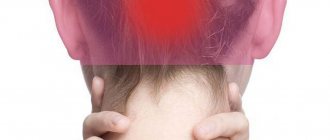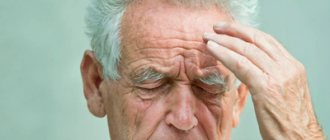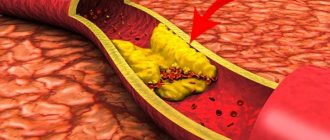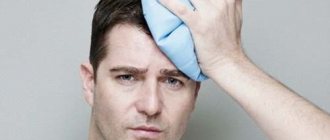Tension headaches are typically diffuse, mild to moderate in intensity, and are often described as feeling like a “tight band” around the head. Tension headache (TTH) is the most common type of headache, yet the causes of this type of headache are still not well understood.
Treatment for tension headaches is quite effective. Management of tension-type headaches is often a balance between a healthy lifestyle, the use of non-drug treatments, and adequate drug treatment.
What is this
Tension headache is attacks of monotonous pain of a constraining nature, usually spread throughout the entire head, sometimes with an emphasis on one area: on the back of the head and back of the head, temples or forehead and eye sockets. The most important difference from other types is symmetry: it is impossible to say whether it hurts more on the right or left. It was as if they were wearing a tight helmet.
Up to 15 days of torment per month (every other day or 3-4 times a week) is an episodic headache, and more than 15 and lasting for six months is chronic.
TTH does not require further examination, but this decision is made by the doctor, taking into account all the symptoms. Read more: Additional examination of headaches.
Symptoms
It feels like a tensor headache is not as pronounced as, for example, the pain of migraines. However, it can be longer lasting and appear regardless of physical activity or other external causes. Sensations appear suddenly and disappear just as quickly, and they can occur at any time of the day. Pain is divided into two types.
- Chronic pain is defined by the fact that it occurs quite often, the pain is pulsating, concentrated mainly in the frontal or occipital part of the head.
- Periodic pain can be identified by a feeling of slight compression of the forehead or pressure in the back of the head and possibly the neck. Usually the pain is not too pronounced and a person can simply endure attacks.
However, it is worth noting that the disease can worsen not only your current well-being, but also your sleep, appetite, and mood. Therefore, if symptoms are detected, it is better not to force yourself to endure an attack, but to undergo treatment in a timely manner.
How it works
The pathogenesis of pain is not yet fully known, but the latest theory suggests the cause is a combination of abnormal neuronal sensitivity and pain; the hypothesis of muscle tension was rejected (proof). Previously, it was believed that tension and, ergo, the development of pain, arises due to sitting in a long awkward position (at the computer, of course), which leads to distortion of the spine and overexertion
muscles of the back, neck and head, which naturally begin to ache on their own - and in the process put pressure on blood vessels and nerves. Alas, such muscle contraction, according to new ideas, is only a secondary symptom.
How then do people tense up?
- Recent studies have found that with tension headaches, the main common factor in all patients with such pain is stress;
- a good addition to it is a disrupted sleep schedule;
- coupled with this is poor nutrition and periodic fasting (meaning skipping meals);
- and finally, eye strain is the icing on the cake.
Tension headache
Causes
The following factors contribute to the development of tension pain:
- stressful effects;
- lack of sleep, uncomfortable headboard;
- non-compliance with the rest regime;
- incorrect posture;
- osteochondrosis, spondylosis;
- critical days for women;
- long work in a forced position;
- visual strain (for example, among jewelers);
- overheating or hypothermia;
- overdose of psychostimulant drugs.
Overstrain of the muscles of the eyes, face, and scalp is a direct path to tension-type pain. Spasmed muscles compress the vessels of the head, which worsens local blood flow with the formation of pain syndrome. Even trismus of the lower jaw muscles can cause discomfort, which is why tension headaches are often combined with temporo-mandibular syndrome.
Symptoms
The clinical picture of tension pain is typical:
- feeling of tightness around the head;
- aching, dull pain;
- discomfort in the neck and shoulder girdle.
Episodic pain lasts from half an hour to several hours with varying intensity. The subsidence of the severity of symptoms may be replaced by a worsening of the condition. No nausea or vomiting is observed. Patients compare the sensation to pressure from a vice, a helmet, or a band tightly tied around the head. The number of “painful” days is less than 15 per month. If symptoms persist for more than 15 days for at least 3 months, we can talk about the process being chronic.
Treatment
Conventional analgesics only dull the pain without solving the underlying problem. The discomfort returns as soon as the drug stops working. All this time, brain tissue experiences oxygen starvation due to spasm of muscles, blood vessels and nerves. A posturologist identifies initial pathological changes and carefully eliminates them using gentle but effective reflexology techniques. The elements of the postural system “learn” to work harmoniously, without the formation of functional blocks and myofascial tension.
The effectiveness of the treatment methods used is easy to notice even with chronic tension headaches. Massages, physiotherapy, muscle relaxation techniques, exercise therapy restore postural balance, also having a beneficial effect on the patient’s psycho-emotional state. An integrated approach provides long-term results, making it possible to appreciate a new quality of life without constricting pain and pills. Improvement is observed from the first procedures, the course of treatment is individual for each patient.
Doctor, what will happen to me?
The most correct treatment for chronic tension pain is a rational lifestyle, see prevention.
Episodic headaches (up to 15 days a month) can be easily stopped with analgesics (the simplest ones: Paracetamol, Citramon; leave Nise and Ketanov for other cases).
If you are lazy, and pills help well more than 4 times a week, then you will soon find out what an overdose of painkillers is, so it is strongly recommended not to take a lot of medicines without consultation.
Prevention
Main article
:
Healthy lifestyle
People who constantly suffer from the described variant of headache need good activity during the day, proper sleep patterns, physical activity, proper nutrition, they need to learn to relax and go on vacation in a timely manner, spending it in active recreation, and not in front of the TV.
“What, is that all?
Doctor, I know this without you! Are you going to treat me?" - Typical patient.
No: as always, the most important treatment is not the pills, but you. In addition to you we will use:
- Tricyclic antidepressants: Amitriptyline and Imipramine (proof);
- Mirtazapine and Venlafaxine in the second line (proof);
- Topiramate and Valproate are also effective, but last.
The previously used ones have not proven their effectiveness: SSRIs (although in occasional cases they help to cope with lifestyle), beta blockers, muscle relaxants (proof once or twice).
2. Causes of the disease
Headaches are the result of interactions between the brain, blood vessels and surrounding nerves. When you have a headache, specific nerves in the blood vessels and muscles of the head become active and send pain signals to the brain.
Headaches that come on suddenly are usually associated with illness or infection. Often an acute headache begins due to sinusitis (inflammation of the paranasal sinuses), pharyngitis (inflammation of the throat) or otitis (inflammation of the ear).
In some cases, headaches can be the result of a blow to the head, injury
or, less commonly, a sign of
a serious illness
.
Causes of tension headaches
and
chronic headaches
include emotional stress, alcohol consumption, poor nutrition, changes in sleep patterns, overuse of medications, and depression. Headaches can also occur due to eye strain, as well as neck or back strain due to poor posture.
Headaches can begin due to some household factors
– for example, passive smoking, strong odors from perfumes and household chemicals, exposure to certain allergens, products, as well as stress, polluted air, noise, lighting, weather changes. Sometimes your head starts to hurt after excessive physical activity.
In order to find out the causes of headaches in each specific case, it is necessary to consult a good doctor.
Visit our Neurology page
More
- Headache
- Compilation article on the most common headaches;
- In what cases is it necessary to be examined?
- Recommendations for patients with tension headaches;
- Migraine;
- Cluster headache;
- More details on Medline;
- Details for people on the NHS.
| [ + ] Tension headache is detected using a hammer. | |
| Head | Headache: Primary ( Tension • Migraine • Cluster) • Secondary (Abusus • Vascular • CSF) • Additional examination of headache Concussion • VSD • Dizziness • Stroke • Dementia |
| Rest | Osteochondrosis • ALS • Sensory disorders • Paresthesia • Polyneuropathy • Guillain-Barré syndrome • Multiple sclerosis |
| Epi | Epilepsy • Classification Seizures: Absence • Treatment |
Causes
The causes of tension headaches are not known. Medical experts believed that tension headaches occur due to problems in the muscles of the face, neck and scalp, which in turn are caused by strong emotions, excess exertion or stress. But research shows that muscle spasm is not the cause of this type of headache.
The most common theories hold that there is an increased sensitivity to pain in people who have tension headaches and perhaps have an increased sensitivity to stress. Increased muscle soreness, a common symptom of tension headaches, may be a result of increased overall pain sensitivity.
Triggers
Stress is the most common trigger that causes tension headaches.
Risk factors
Risk factors for tension headaches include:
- Gender. Women are more likely to get this type of headache. One study found that nearly 90 percent of women and 70 percent of men experience tension headaches during their lifetime.
- Average age of the patient. The incidence of tension-type headaches peaks around age 40, although these headaches can develop at any age.
Complications
Due to the fact that headaches can be quite common, they can significantly affect work productivity and overall quality of life, especially if they become chronic. Frequent pain can disrupt your usual lifestyle and overall performance.
Why do tension headaches occur?
VSD occurs for various reasons. Pathology can be caused by systematic stress, constant lack of sleep, mental and physical fatigue, poor diet, and other factors. However, the main reason is stress. It is worth noting that stress can be associated with both external and internal factors: constant worries, fears, mental trauma - everything that prevents a person from being at peace.
Neck muscle tension
Often, TTH occurs due to muscle tension:
- trapezoidal;
- occipital;
- sternocleidomastoid;
- temporal;
- neck extensors.
An increase in the tone of these muscles occurs against the background of nervous tension. As a result, a chain reaction occurs - muscle tension causes compression of the blood vessels located in them, as a result of which blood circulation is disrupted and swelling appears. Increased muscle tone also has a negative effect on nerve endings, because squeezes them. All this causes pain in the head. Therefore, to treat tension headaches, it is necessary to conduct a complete examination of the vessels of the head and neck.
Uncomfortable position
TTH usually occurs during daylight hours. In addition to mental stress, this type of pain can appear due to prolonged exposure to an uncomfortable position. For example, during prolonged handicrafts, when a person is forced to take a suitable position to examine small details. The situation is aggravated by the fact that sometimes you have to spend a lot of time in an unnatural position.
Tension headaches are a common companion for drivers. The mechanism of its occurrence is similar: while driving a vehicle, you need to carefully look at the road, and especially if you have to travel at night. Another of the most common causes of tension headaches is an uncomfortable place or position to sleep.
It is worth noting that the above factors do not cause headaches on their own, but because prolonged stay in an uncomfortable position increases nervous tension. Activity in such poses always requires serious concentration.
Nervous tension and stress
Mental tension occurs due to stress, depression and anxiety disorders. Almost all people with tension headaches experience constant anxiety. This is a character trait. They cannot relax because they are expecting something negative. By and large, such individuals are under systematic stress. The nervous system is constantly in an excited state, which causes a decrease in the pain threshold. Headache in such persons intensifies due to fear, worries, anxiety, and emotional stress.
Problems with the thyroid gland
The thyroid gland produces thyroid hormones, which are critical for normal metabolism in the body. Among the main signs of dysfunction of this important organ are tension-type headache, excessive fatigue, drowsiness and other symptoms that have much in common with vegetative-vascular dystonia. Therefore, in such a situation, it is necessary to do an ultrasound of the thyroid gland and donate blood for hormones.
Features of manifestations
Tensor pain tends to appear suddenly at any time of the day, and then just as suddenly go away. It can be periodic and occur rarely, passing quickly. It can also be chronic – it lasts for more than 2 weeks within one month, occurs frequently and persists for a long time. The intensity of pain is not affected by physical activity.
The nature of the pain can be different. There may be a feeling of pulsation in the head (in the temples, back of the head, forehead), there may also be a feeling of compression in certain parts of the head, or a feeling of a “vice” squeezing the entire head. Pain often occurs in the afternoon or evening.
In addition to the pain itself, the patient experiences the following symptoms:
- absent-mindedness, impaired concentration;
- general fatigue;
- “fog” in the head;
- pain and tension in the muscles of various parts of the body;
- negative reaction to loud sounds and bright lights;
- increased fatigue;
- decreased appetite;
- irritability;
- sleep disorders.
Tension headaches are easier to tolerate than migraines. However, pain and associated symptoms affect quality of life, reduce sleep quality, cause appetite disturbances, affect mood and may contribute to the development of depression.
Many patients experience changes in posture. This is due to the body's defense mechanism, when, under stress, the brain receives a command to either be ready to run or group. Externally, this manifests itself in bending the neck down, raising the shoulders, and rounding the back.
Chronic headache (cephalgia): symptoms and treatment
Cephalgia, or headache, is a nuisance that everyone has experienced at some point in their lives. This may be due to injury, overexertion, or hypertension. But the fact is that chronic cephalalgia (lasting for several days, for example) also occurs. Let's talk about this.
Symptoms
Of course, the manifestations of chronic cephalgia are countless, since there are also many ailments that constant headaches may indicate. For example, Dr. V.N. Shtok in 1987 proposed a division into the following types of chronic cephalalgia:
- Neuralgic;
- Vascular origin;
- Mixed;
- Muscle tension;
- Liquorodynamic;
- Psychalgia.
The development of medicine has made it possible to identify the following signs that you need to pay attention to first if a person experiences chronic headaches:
- Increasing power of cephalgia if you have to strain, sneeze or cough;
- Unexpected severe pain syndrome (possibly subarachnoid hemorrhage);
- Morning cephalalgia, and if nausea, vomiting and dizziness are also a sign, then we can judge the possible extensive course of the brain disease. As a rule, in this case, venous pressure may decrease;
- If a few days after the injury pain appears (subdural hematoma);
- Constant powerful cephalalgia for several hours, days, weeks may indicate a suspicion of a brain tumor, meningitis, encephalitis, but a possible illness is also chronic muscle pain, which can last more than 15 days a month or 180 days a year;
- If pain sensations that appear at night contribute to awakening from sleep (migraine, cluster headache).
Diagnostics
Diagnostics must be carried out by specialists in order to identify the ailment that torments the patient. The following methods are used for this:
- EchoEG (using this method, dilation of the ventricles in the brain is usually diagnosed);
- EEG (if there is a suspicion of migraine cephalgia);
- study of cerebral hemodynamics (blood circulation, blood vessels are diagnosed, signs of venous cephalgia can be seen);
- MRI, CT (to exclude tumors in the brain).
Therapy
Today there are 2 methods of therapy. The first involves prevention, the second - relieving the symptoms of a sudden attack (usually used in the treatment of migraines).
Preventive treatment consists of reducing the frequency, duration and severity of pain. This includes, depending on the pathology, types of therapy such as:
- Botulinum toxin (Botox injections);
- Antiepileptic drugs (Topiramate Gabapentin, Valproate);
- Venotonic drugs;
- Calcium antagonists;
- Ergotamine preparations;
- Cavinton cerebrovascular accident corrector;
- Sedatives (valerian, motherwort, mint, barbiturates);
- Antidepressants (Fluoxetine Amitriptyline);
- Central muscle relaxants (Mydocalm, Tizanidine);
- Non-steroidal anti-inflammatory drugs (Aspirin, Ibuprofen, Diclofenac);
- Etc.
An important clarification: medications are not a guide to action, since certain medications are used in different cases. For venous pain, it is unacceptable to use calcium antagonists, and for vasomotor pain, venotonics. This should be taken into account. Treatment is prescribed by a doctor based on the diagnosis.
With the development of botulinum therapy, the effectiveness of botulinum toxin for chronic migraine has been proven. In the USA, operations have already been performed with Botox injection and removal of the trigeminal nerve, after which the patient’s migraine disappeared.
In addition, massage, physical therapy, and psychological therapy methods will be used.
Psychotherapy is effective if the patient has a disease that accompanies the disease, and also if the patient does not respond to drug treatment. Author: K.M.N., Academician of the Russian Academy of Medical Sciences M.A. Bobyr
Causes and provoking factors
Every person can experience TTH throughout their life, since the trigger is nervous or mental stress. Anxiety, a busy work schedule, stressful situations, and excessive mental stress can trigger an attack of tensor pain. The headache begins to hurt a few hours after experiencing stress or in the afternoon.
Other causes of tension-type headaches:
- lack of sleep, uncomfortable posture during sleep;
- violation of diet, frequent fasting;
- uncomfortable working environment - noise, too bright lighting, lack of oxygen, heat, dry air;
- forced uncomfortable posture, prolonged work at the computer;
- arterial hypertension, hyperthermia, hypoglycemia, hormonal disorders, PMS;
- anxiety states, panic attacks;
- Excessive consumption of coffee and energy drinks.
The longer the attack persists, the stronger it is, and accompanying symptoms appear.
The mechanism of development of HDN
Under the influence of provoking factors (prolonged visual stress, uncomfortable posture), overwork of the muscles of the face, neck, shoulders, and back occurs. This leads to the accumulation of lactic acid in muscle tissue, which causes pain and spasm.
Muscle spasms are accompanied by poor circulation, causing damage to the brain and vascular system. The pain is increasing.








